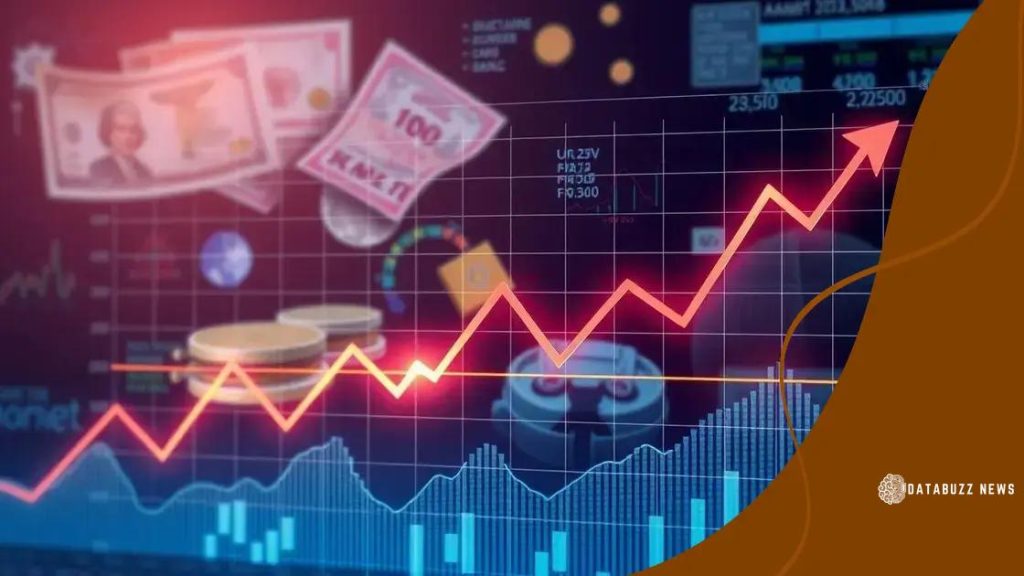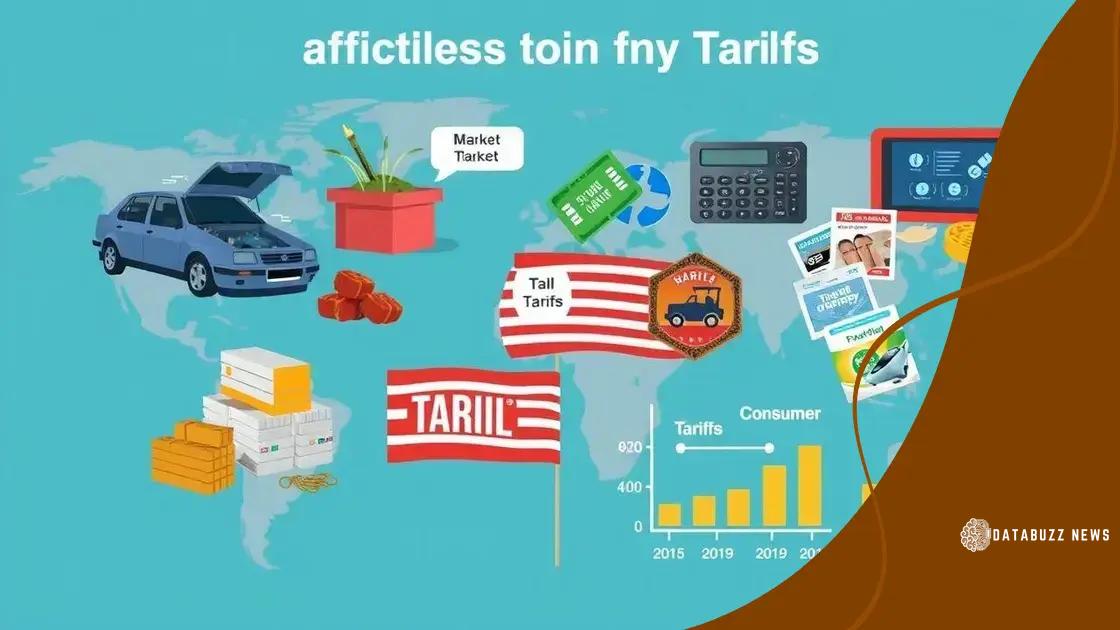Tariffs spark market swings: what you need to know

Tariffs spark market swings by increasing import costs, leading to price changes in goods and significant impacts on various sectors, including manufacturing and agriculture, while also influencing global trade dynamics.
Tariffs spark market swings that can send shockwaves through the economy. Have you ever wondered how these trade policies really affect your investments? Let’s dive into the details.
Understanding the basics of tariffs
Understanding tariffs is crucial for anyone interested in global trade. These policies can have a major effect on market fluctuations and investment opportunities.
At their core, tariffs are taxes imposed on goods imported from other countries. They serve multiple purposes, such as protecting local industries and generating revenue for governments.
Types of Tariffs
There are several types of tariffs that can impact the economy:
- Ad valorem tariffs: These are based on a percentage of the item’s value.
- Specific tariffs: These are fixed fees based on the quantity of the goods.
- Compound tariffs: These combine both ad valorem and specific tariffs.
- Revenue tariffs: Primarily designed to raise funds for the government.
The imposition of tariffs can change the price of products, making imported goods more expensive. This often leads consumers to consider local alternatives, which is beneficial for domestic producers.
However, it’s important to recognize the potential downsides of tariffs as well. They can escalate into trade wars, prompting retaliatory measures from other countries. This can disrupt the flow of trade and harm international relationships.
The Impact of Tariffs
The effects of tariffs can ripple through the economy. For instance, increased prices can lead to inflation, harming consumers’ purchasing power. In addition, businesses reliant on imported materials may face higher costs, impacting their profit margins.
Overall, understanding how tariffs work and their potential effects on the market is essential for investors and consumers alike. Being informed allows individuals to make better decisions in a rapidly changing economic environment.
How tariffs influence market fluctuations
How tariffs influence market fluctuations is an important topic for consumers and investors alike. When tariffs are implemented, they can cause immediate reactions in financial markets.
One significant effect is that tariffs can raise prices on imported goods. This may shift consumer behavior, pushing buyers toward domestic products. As demand for local goods increases, this can lead to a rise in stock prices for those companies.
Immediate Market Reactions
The introduction of tariffs often leads to immediate market volatility. Investors may react quickly, causing fluctuations in stock prices. Market indices can swing up or down based on news about trade agreements or tariff announcements.
- Increased volatility: Stock prices can fluctuate dramatically in reaction to tariff news.
- Sector impact: Certain industries may benefit, while others suffer due to tariffs.
- Long-term outlook: Investors will analyze potential long-term impacts of tariffs on specific sectors.
This volatility affects not just investors, but also ordinary consumers who may face higher prices. Retailers, in particular, might pass on these costs to customers, leading to inflation.
When trade tensions rise, the uncertainty can further exacerbate market swings. Companies that depend on global supply chains may find their operations disrupted, leading to decreased profitability. Investors must stay informed about global trade dynamics as they have direct implications for market performance.
Analyzing Market Trends
To navigate these fluctuations effectively, understanding market trends is key. Investors often look for patterns that indicate how tariffs might influence specific sectors over time. Monitoring economic indicators can provide insights into potential market movements influenced by tariff policies.
As these elements combine, it is clear that tariffs shape more than just trade—they affect the entire market landscape. Awareness and analysis will empower individuals to respond strategically to the changes brought on by trade policies.
The impact of tariffs on various sectors

The impact of tariffs on various sectors can be vast and complex. Different industries react differently based on their reliance on imported goods and global supply chains.
For example, the manufacturing sector often feels the effects of tariffs most acutely. When tariffs are imposed, the cost of imported materials increases, which can slow down production and drive up prices. This situation can cause a ripple effect throughout the economy.
Key Affected Sectors
Several sectors experience significant consequences from tariff policies. These include:
- Automotive industry: Tariffs can increase the cost of imported parts, leading manufacturers to raise vehicle prices.
- Agriculture: Farmers may face retaliation from other nations, causing them to lose important export markets.
- Consumer electronics: Price increases on imported goods can lead to reduced sales and lower profit margins for retailers.
- Steel and aluminum: Tariffs are meant to protect these industries but can lead to higher costs for producers reliant on these materials.
Tariffs can also lead to job losses in sectors that rely on exports. Companies may downsize or relocate production to countries with lower tariffs, affecting local employment. At the same time, sectors that benefit from tariff protection can experience growth and job creation.
Understanding the overall impact on the economy is crucial. While some businesses thrive, others may struggle or even close down, leading to fluctuations in the job market.
Long-term Effects
The long-term effects of tariffs can shape industry dynamics. Companies may adapt by finding new suppliers or investing in local production to avoid tariffs altogether. This shift can change the competitive landscape in various sectors.
As tariffs evolve, businesses and consumers must stay informed to understand their market advantages and challenges. Keeping an eye on global trade agreements and economic trends will help navigate these changes effectively.
Strategies for investors in fluctuating markets
Strategies for investors in fluctuating markets are essential for navigating the unpredictable nature of financial landscapes. Understanding how to manage risks and seize opportunities can make a significant difference.
Investors should focus on maintaining a diversified portfolio. Diversification helps spread risk across various asset classes, reducing the impact of a poor-performing investment. By investing in different sectors, such as technology, healthcare, and consumer goods, investors can better weather market swings.
Key Investment Strategies
Here are some effective strategies for investors:
- Stay informed: Keeping up with economic news and market trends is vital. Knowledge allows investors to make better decisions.
- Use stop-loss orders: These orders help limit losses by automatically selling a stock when it reaches a certain price.
- Consider dollar-cost averaging: This strategy involves investing a fixed amount periodically, regardless of market conditions, which can reduce the impact of volatility.
- Reassess your portfolio: Regularly review your investments to ensure they align with your risk tolerance and financial goals.
Another useful approach is focusing on quality stocks. Investing in companies with strong fundamentals can provide a cushion during market downturns. These companies typically have robust balance sheets and a history of financial stability.
Additionally, considering alternative investments can be beneficial. Asset classes such as real estate, commodities, or bonds can provide diversification and act as a hedge against inflation.
Emotional control
It’s crucial for investors to maintain emotional control during market volatility. Impulsive decisions based on fear or excitement can lead to financial losses. Developing a clear investment plan and sticking to it can help manage emotional responses.
As investors implement these strategies, they can gain confidence in their ability to navigate fluctuating markets. Staying disciplined and informed will enable them to effectively respond to changes and uncertainties.
Future trends in tariffs and global trade
Future trends in tariffs and global trade will shape the economic landscape significantly. As nations rethink their trade policies, understanding these trends becomes crucial.
We are likely to see an increase in protectionist measures as countries strive to protect their local industries. As a result, tariffs may rise, impacting the flow of goods across borders. This shift can create both challenges and opportunities for businesses and consumers globally.
Technological Impacts
Advancements in technology will also play a significant role. As e-commerce grows, tariffs on digital trade may become a pressing issue. Countries may introduce new regulations to manage online sales and services, which can influence global trade patterns. Additionally, improved technologies can streamline supply chains, potentially reducing the need for tariffs.
- Digital tariffs: Countries may start to impose taxes on digital services and goods sold across borders.
- Blockchain technology: It can enhance transparency in trade, helping to avoid tariff evasion.
- Automation: Robotic technologies can reduce reliance on imported labor.
- Sustainability initiatives: Environmental regulations may lead to new tariffs on goods based on their carbon footprint.
Shifts in consumer preferences toward sustainable products can also influence tariff policies. As environmental concerns rise, countries may implement tariffs on products that do not meet certain sustainability standards. This change can affect global supply chains and production practices.
Trade Agreements and Collaborations
In the coming years, we might witness a rise in regional trade agreements as nations seek to strengthen ties with neighboring countries. These agreements could lead to lower tariffs for member nations while increasing tariffs for non-members. Such a trend could drastically change the dynamics of global trade.
Trade relations will continue to evolve, with geopolitical tensions impacting negotiations. Countries may impose tariffs as tools of diplomacy, affecting relationships in the global economy. Understanding these shifting dynamics will help businesses and investors adapt and thrive in this changing landscape.
As we look to the future, understanding the trends in tariffs and global trade is essential for businesses and investors. Protectionist measures may rise, which could lead to increased tariffs and changes in market dynamics. Technology will play a critical role, influencing how goods are traded and taxed. Consumer preferences for sustainability could impact tariff policies, too. Finally, the evolution of trade agreements and geopolitical relations will continue to shape the landscape of international commerce. By staying informed and adaptable, stakeholders can better navigate the complexities of trade and seize emerging opportunities.
FAQ – Frequently Asked Questions about Tariffs and Global Trade
What are tariffs and how do they affect international trade?
Tariffs are taxes imposed on imported goods, which can increase prices and impact trade relationships between countries.
How might technological advancements influence tariffs?
Technological advancements can streamline supply chains, potentially reducing the need for tariffs and changing trade dynamics.
What impact do consumer preferences have on tariff policies?
As consumers increasingly prefer sustainable products, countries may implement tariffs based on environmental standards.
How can businesses adapt to changes in global trade policies?
Businesses can adapt by staying informed, diversifying their supply chains, and developing flexible strategies to respond to changing tariffs and regulations.
